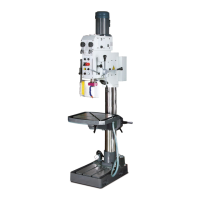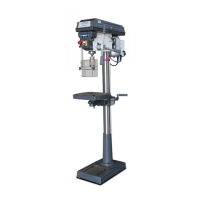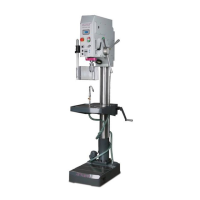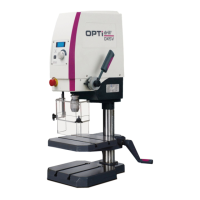Malfunctions
Version 2.1.1 - 2020-07-27 71Translation of original instruction
B40 GSP EN
B40GSP_GB_6.fm
8 Malfunctions
Malfunction Cause / possible effects Solution
Noise during work. • Spindle is too little lubricated
• Tool is blunt or wrongly clamped
• Grease spindle
• Use new tool and check securing
(fixed setting of the bit, bit holder and
chuck).
Bit „burnt“ • Drill speed too high /feed too high
• Chips do not come out of the drill hole
• Drill blunt
• No or too little cooling
• Select another speed
Extract drill more often during work
Sharpen or
use new drill
• Use cooling agent
Drill tip is running off centre,
the drilled hole is non-round
• Hard points on the workpiece
• Length of the cutting spirals/or angles on
the tool are unequal.
• Drill deformed
• Use new drill
Drill bit defective. • No base / support used. • Use support and clamp it with the
workpiece
Drill bit runs unround or
wobbles.
• Drill deformed
• Worn out spindle bearings
• Drill is not correctly clamped.
• Drill chuck defective
• Use new drill
• Have the spindle bearings replaced
• Correctly clamp drill
• Replace the drill chuck
It is not possible to insert
the drill chuck or the taper
mandrel
• Dirt, grease or oil on the taper inside of the
drill chuck or on the taper surface of the drill
spindle
• Clean surfaces well
• Keep surfaces free of grease
Motor does not start • Motor is wrongly connected
• Defective fuse
• Have it checked by authorised person-
nel
Motor is overheating and
there is no power
• Motor overloaded
• Too low mains voltage
• Motor is wrongly connected
• Reduce feed rate
Disconnect immediately and have it
checked by authorized personnel
• Have it checked by authorised person-
nel
Precision of the work
deficient
• Irregularly heavy or tensed workpiece
• Inexact horizontal position of the part holder
• Balance the piece statically and
secure without straining
• Adjust part-holder
Drilling spindle sleeve does
not return to its initial
position
• Spindle return spring does not work
• Locking bolt inserted
• Check spindle return spring, replace it,
if necessary
• Pull out locking pin
The drilling sleeve may not
be moved downwards.
• Locking bolt inserted
• Drill depth adjustment no released
• Pull out locking pin
• Release drill depth adjustment
Spindle bearing overheating • Bearing worn down
• Bearing pretension is too high
• Working at high drilling speed over a longer
period of time.
•Replace
• Reduce bearing slack for fixed bear-
ing (conical-roller bearing)
• Reduce drill speed and feed rate

